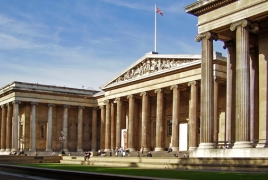 Armenian culture at British MuseumOver 175 manuscripts With a history going through millennia, the Armenian culture is represented at museums across the globe, attracting attention of visitors. The British Museum in London is one of the places where numerous Armenian artifacts are displayed. PanARMENIAN.Net - The British Museum is dedicated to human history, art, and culture, located in the Bloomsbury area of London. Its permanent collection, numbering some 8 million works, is among the largest and most comprehensive in existence and originates from all continents, illustrating and documenting the story of human culture from its beginnings to the present. The British Museum was established in 1753, largely based on the collections of the physician and scientist Sir Hans Sloane. It first opened to the public on January 15, 1759. Anatolia and Urartu (Room 54) Ancient Anatolia and Urartu form an important land link between Europe and Asia and lie where the modern Republic of Turkey, Armenia, Georgia and north-west Iran are located today. Objects in Room 54 show different cultures from Prehistoric to Hellenistic times. Examples of Early Bronze Age craftsmanship on display include silver bull and cup. Business archives of Middle Bronze Age merchants illustrate trading between central Anatolia and Mesopotamia (modern Iraq). Delicate gold jewelry and figurines date from the Hittite period. Iron Age objects from Urartu, include winged bulls and griffins used to decorate furniture. On the left: bronze human-like winged bullocks from Rusakhilini, 700 year BC. On the right: gold statuette of god, 8th-7th century BC, Urmia The showpieces dating back to Urartian times have long been displayed at the British Museum under the name of “Ancient Turkey”. After several years of talks with the museum administration and a petition signed by over 12,000 people, the pavilion was renamed as Anatolia and Urartu. It exhibits metal and clay pitchers, weapons, belts, helmets, jewels, as well as tools made of stone and obsidian. The pitchers found during excavations at Karmir Blur are among the most interesting objects. On the left: wine pitchers, 7th century BC, Urartu. In the middle: bronze helmet, 9th-8th century BC, presumably from the territory which is now northeastern Iran. On the right: cylindrical seal and die with heads of animals imprinted, Armenian Highlands, 8th century BC. About 175 manuscripts are kept at the museum’s library, including one written by Vardan, who is presumably the author of the largest Armenian manuscript “Msho Charantir” (The Homilies of Mush). The manuscript dating back to 1200-1201 was found at Avag Monastery near Yerznka city. There is also a Gospel book copied by Stepanos Vahkatsi in Cilician capital Sis. The book was once owned by the son of King Hetum’s brother and later by Khoja Nazar, the mayor of Old Jugha. Gospel Book, 1434 Besides, the British Museum exhibits 3 books illustrated by Hakob Jughaetsi, as well as objects of arts and crafts, pottery, curtains and carpets. The head of the bronze gilded statue of Armenian Goddess Anahit is displayed in Room 22, The World of Alexander, with a description reading: “Bronze head of a goddess, probably Aphrodite.” On the left: the statue of Anahit. In the middle: Artavazd IV, 4th-6th century AD. On the right: brone model of a wall in Rusakhinili, Urartu Lusine Dallakyan / PanARMENIAN.Net Related issues: A non-exhaustive summary of war crimes Months-long project in Italy highlights culture and nation From an American Colonel's report A timeline of how the war machine was set in motion The situation is scarier than one can imagine And the Pulitzer Prize went to… a lot of Armenians Azerbaijan’s violence in April War |